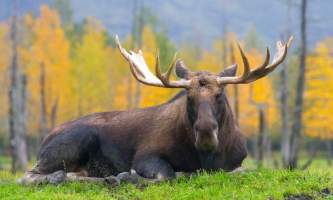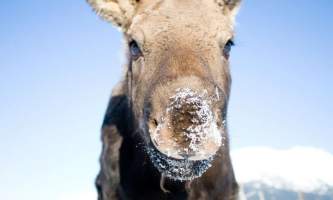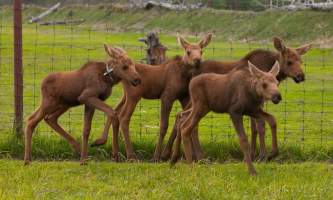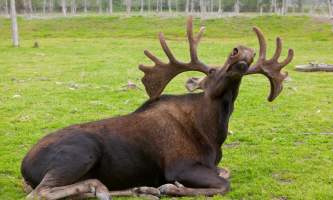Moose
Here we are at the moose habitat at the Alaska Wildlife Conservation Center.
Moose are the largest member of the deer family, and the Alaskan Yukon Moose is the largest of the moose family. At birth, calves typically weigh approximately 25 pounds. Adult females weigh 800 to 1,300 pounds. Adult males weigh 1,100 to 1,600 pounds. Moose can reach up to 6’ tall at the shoulder with long legs allowing moose to wade through deep snow in winter and out into ponds in the summer to search for underwater vegetation and keep cool.
Moose are well adapted for winter. Much like the caribou, the individual hairs in a moose’s pelt are hollow, providing additional insulation during the cold months. Not only is their nose covered in fur, the series of passageways inside the large nose of a moose warms incoming air before it reaches the lungs and retains water vapor as moose exhale; an adaptation that aids in water conservation at times of the year when all water is frozen.
Moose are great swimmers and through an adaptation in their noses can also close off the passageways to their lungs, dive down into shallow waters and eat protein rich grasses on the bottom of lakes. Their long, goofy noses are also useful so they can keep their eyes above the water line to watch out for predators.
Moose are also "ruminants", or cud chewers, as they have four chambers of their stomach. They resemble a cow in this way and can often times be seen munching. Like a parent with toddlers, we don’t worry about what it is as long as it’s food.
As previously mentioned, moose are members of the deer, or cervid family, where the males grow a set of antlers annually. Moose antlers are also particularly interesting, especially in the early summer, as moose antlers have the opportunity to grow one pound a day, or over one inch a day. Some of the largest moose antlers shed that we have found in recent years have spanned over 6 feet in width and have weighed over 80 pounds. Bullwinkle was jealous!





